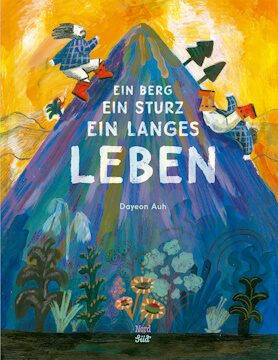Dayeon Auh
Ein Berg, ein Sturz, ein langes Leben
[The Three-Year Tumble]
- NordSüd Verlag
- Zurich 2024
- ISBN 978-3-314-10683-5
- 40 Pages
- Publisher’s contact details
For this title we provide support for translation into the Polish language (2025 - 2027).
Sample translations
A riot of tumbles and somersaults, dances and hops…
A mere glimpse of the frontispiece already gives us a good idea of where we’ll be heading in the picture book Ein Berg, ein Sturz, ein langes Leben, namely into a wild and dangerous mountain landscape. Standing there like a huge purple sugarloaf is a terrifying mountain, jutting up boldly into the golden sky, its feet a tangle of all manner of weird plants. On one side of the mountain we see a booted, bearded man dashing with seeming ease up the steep incline; on the other side we see the same man tumbling head over heels back down again. A perfect parable, if ever there was one, of the challenges of life!
In point of fact the South Korean artist Dayeon Auh, who now lives in Germany, takes the young readers of her picture book – and indeed anyone else who enjoys immersing themself in wise tales – into the world of a traditional South Korean fairytale about a grandfather and his young granddaughter. Well, yes and no! It’s actually about something much bigger, namely about the art of defying all the inevitable tumbles along the sometimes bumpy road of life, getting back on our feet, shaking the dust from our clothes and our hands, and forging on full of hope and courage. The fairytale begins by telling us that, according to legend, anyone who stumbles and tumbles on the mountain at the foot of which the grandfather lives will only live for another three years.
But let us first take in the grandfather’s peaceful world with the marvelling eyes of a child. Every single scene is captured on paper with higgledy-piggledy verve – as though painted by a child with broad brush strokes and lashings of wax crayon; with crazy perspectives; with spatial relations between different objects that turn the real world upside down; with creatures that could easily have been summoned up by the rampant imagination of a child. The old man with his sticky-out hair and a massive beard is standing there in the garden in front of his little timber cottage, clad in boots and a check-patterned lumberjack shirt and carrying a knobbly stick. We presume that he is very content with everything he surveys in his little world: enchanting little plants, a tree radiant with vigorous, fresh green leaves, a few fantastical creatures, a sky patterned in golds and yellows — and there, on the horizon: the mountain. The overall effect is that of a motley painting dashed down by a child – spidery, spirited, and brought to life without a moment’s hesitation straight from the child’s fertile imagination. Given the panoply of beauty all around him, it is no wonder that the grandfather wants to carry on living for a a lot longer! But the almost paradisal mood of the story’s beginning gives way to a dramatic narrative that unfolds in successive illustrations and shows the grandfather’s idyll fairly falling apart.
The old man sets off for market once again. And his route takes him over the mountain. On the way he suddenly hears a rustling in the undergrowth, which startles him – and makes him fall over. ‘For heaven’s sake!’ he bursts out, as the thought strikes him in a flash: ‘Another three years and I’ll be dead!’ When it comes to the end of this three-year period the grandfather really does start feeling iller and iller. Even the finest doctor far and wide doesn’t know what’s wrong with the old man (a psychologist would say ‘A classic case of a self-fulfilling prophecy!’) But then his clever little granddaughter comes for a visit, puts her thinking cap on, and a brilliant idea suddenly pops up in her speech bubble: ‘Grandpa, if you fall over again you’ll live an extra three years longer. And if you then fall over again, you’ll live an extra six years longer. And if you fall over a third time, you’ll live no less than nine years longer…’
Eureka! The grandfather’s mood immediately starts to improve. He gambols and dances and tumbles and somersaults and picks himself up again and dances to the absolute delight of all the young and old watching his joyful cavortings. Even the birds start to laugh, and the entire motley world of this picture book dances and whirls in sheer jubilation. Even the fearsome mountain itself can’t stop laughing, and amiably turns itself into a gentle blue-green-red-grey-purple hillock on which the assembled people can leap around on to their heart’s content. No wonder that they henceforth call it ‘The long and happy life mountain’.
What a rare thing it is for two wise perspectives on life – the perceptive view of a child, and the joy of life as recaptured by an old man – to be brought together in such an eminently agreeable way and rendered comprehensible by young and old alike!
Translated by John Reddick

By Siggi Seuß
Siggi Seuß, freelance journalist, radio script writer and translator, has been writing reviews of books for children and young people for many years.
Publisher's Summary
There is a legend that anyone who takes a tumble on this particular mountain has only three more years to live. One day catastrophe strikes: grandfather falls down! He loses the will to live and begins to feel mortally ill. Just before the end of the three years his grand-daughter comes to stay, and she sees things completely differently. All of a sudden the mountain acquires a quite new significance.
The story derives from a traditional Korean folk tale, and it bespeaks a refreshing optimism. This optimism is rendered powerfully visual through the illustrations in this debut book by Dayeon Auh.
This is a book for those who like to take a positive stance in their lives.
A look into the book Ein Berg, ein Sturz, ein langes Leben
(Text: NordSüd Verlag)
